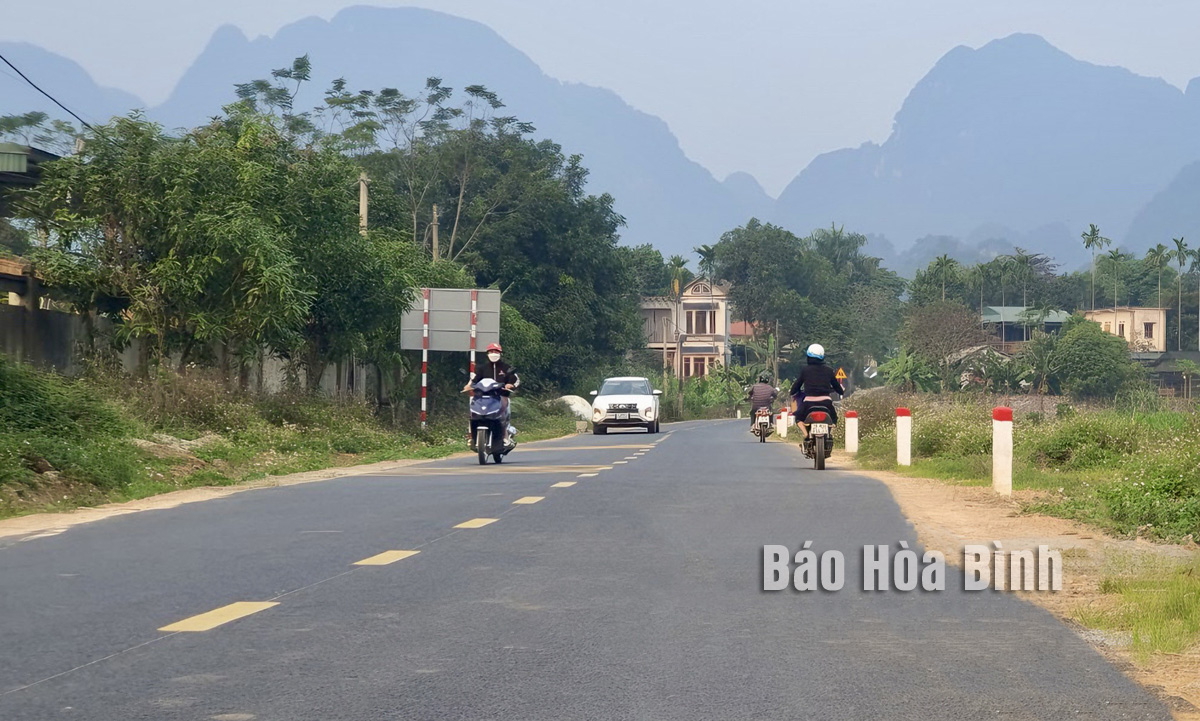
Kim Boi district is drafting 23 planning projects which are expected to help boost the local socio-economic development, attract investors, and mobilise resources for development, said Vice chairman of the district People’s Committee Tran Tuan Son.
They include the one on Bo urban area development until 2045, 20 zoning, and 12 on rural residential areas in communes.
Road in Mo Da hamlet, Bo town in Kim Boi district, upgraded and expanded to serve local tourism development.
According to the spatial development orientation of Hoa Binh province by 2020 with a vision to 2030, Kim Boi is located in Sub-Region 2 in the east and south of the province. It’s the province’s sub-region for industry - tourism - trade - agriculture - forestry development. The district connects to important national economic corridors such as Ho Chi Minh Highway, National Highway 21, and National Highway 12B and adjacent to Hanoi and the provinces of Ha Nam, Thanh Hoa, and Ninh Binh. In addition, the district is located on the main economic corridor Luong Son - Kim Boi - Lac Thuy which borders Hanoi.
Planning is identified as one of the strategic breakthroughs to successfully implement the targets set by the Resolution of the 17th provincial Party Congress. It is expected to help attract investment and boost local socioeconomic development. Therefore, the Kim Boi district People's Committee continues to allocate resources to soon complete the appraisal dossier. However, according to the committee, to increase their efficiency, general planning and zoning need to be integrated with other specialised plans. This requires further coordination between localities, departments, and agencies to promptly remove difficulties and obstacles.
Planning is an important legal tool to manage and mobilise resources and ensure long-term development. It will be a basis to build medium-term public investment plans, construction plans, urban–rural development plans, and specialised technical plans in the district.
Son affirmed that the district will prioritise resources to complete the planning work which is considered one of its key tasks now.
Hoa Binh province is undergoing a dynamic transformation amid Vietnam’s national digital transition. Building on Poliburo’s Resolution No. 57-NQ/TW on breakthroughs in science, technology, innovation, and national digital transformation, the province has rolled out a wide range of practical action plans. A standout initiative is the "Digital Literacy for All” movement, an effort to ensure that no one is left behind in the digital era.
Hoa Binh province is undergoing a dynamic transformation in the wake of the national digital transformation movement. Building on Resolution No. 57-NQ/TW of the Politburo on breakthroughs in science, technology, innovation, and national digital transformation, the province has implemented a wide range of practical action plans. A standout initiative is the "Digital Literacy for All” movement ambitious effort to ensure that no one is left behind in the digital age.
With a spirit of unity and proactive problem-solving, the Party Committee, the government and the people of Dong Lai Commune (Tan Lac District) have made great strides in implementing the resolutions of the 24th Party Congress of the commune for the 2020 - 2025 term. Focusing on leadership and practical actions, the commune has brought the Party’s resolutions into daily life, creating strong impacts and pushing the local development forward.
Amid the nationwide push for digital transformation, young people in Hoa Binh Province are stepping up as dynamic pioneers, applying technology to enhance Youth Union operations and expand the reach of youth-led initiatives. Through creativity and adaptability, Youth Union organizations at all levels have introduced a series of practical solutions, contributing to modern governance and community development.
In recent years, An Nghia commune, located in Lac Son district, has stepped up administrative reform, focusing on improving the quality and efficiency of its single-window service unit for receiving and processing administrative procedures. These improvements have helped create favourable conditions for local residents and organisations to handle administrative procedures, contributing to the commune’s broader socio-economic development.
The Prime Minister-approved master plan to develop the multi-use value of forests ecosystems through 2030, with a vision to 2050, aims to improve the management and sustainable use of forest resources, create jobs, increase incomes, and improve the living standards of ethnic minorities, people in mountainous and remote areas, forest workers and those living near forests.



